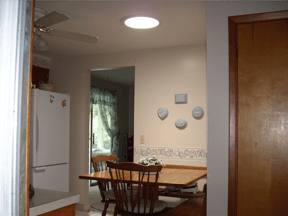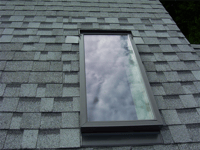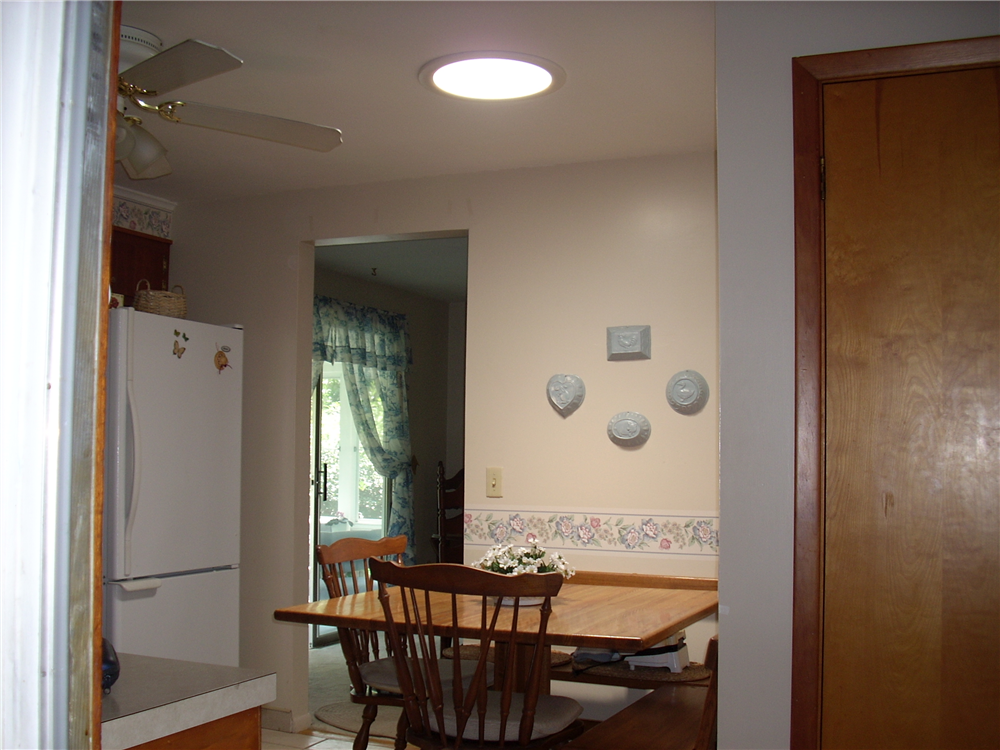 Skylights and sun tunnels provide daylight and warmth to a home, especially in dark rooms with small or few windows. New designs now give homeowners a wide variety of options for adding natural light and ventilation. No-leak skylights have now replaced the dripping units of the 1960s and the acrylic bubbles of the 1980s. Today's skylights have added layers of water protection and better flashing design. New glazes help to improve energy efficiency. Venting can be done at the touch of a button.
Skylights and sun tunnels provide daylight and warmth to a home, especially in dark rooms with small or few windows. New designs now give homeowners a wide variety of options for adding natural light and ventilation. No-leak skylights have now replaced the dripping units of the 1960s and the acrylic bubbles of the 1980s. Today's skylights have added layers of water protection and better flashing design. New glazes help to improve energy efficiency. Venting can be done at the touch of a button.
One of the latest designs in natural lighting is the sun tunnel, or tubular skylight. The flexible design of the sun tunnel permits the unit to bend around attic obstructions to maximize sunlight. On the exterior, sun tunnels look like small domes and are the perfect unit for bathrooms, storage spaces, and kitchens. Sun tunnels are easy to install and are being used by architects in "green" building projects. Sun tunnels take up a small area on the roof and minimize heat gain in the summer and heat loss in the winter. Their size also minimizes their impact on the architecture of a home.
If you're adding skylights or sun tunnels, climate and your home's design should be the primary factors in selecting the appropriate unit. Here are some things to consider:
- The physical size of the skylight impacts the illumination level and temperature of the space.
- As a general rule, a skylight size should be less than 5 percent of the floor area in a room with many windows and less than 15 percent of the floor space of a room with few windows.
- In Central New York, we experience short summers and long winters. You may want to maximize passive solar heating potential. The placement of skylights on the roof will affect heat gain. East-facing skylights will maximize heat gain in the morning. West-facing skylights will maximize heat gain in the afternoon while south-facing has the greatest potential for heat gain than any other location.
 Skylights have become more energy efficient and new glazes help to control the problem of solar heat gain in the summer months. Glazing will also impact performance. The types of glazing include heat-absorbing tints, insulated glazing (double-glazed, triple-glazed), and low emissivity (Low-E) coatings.
Skylights have become more energy efficient and new glazes help to control the problem of solar heat gain in the summer months. Glazing will also impact performance. The types of glazing include heat-absorbing tints, insulated glazing (double-glazed, triple-glazed), and low emissivity (Low-E) coatings.- Solar blinds improve the energy efficiency of skylights. Blinds can be manually or electrically operated and are available in blackout and light-diffusing materials. Solar blinds may also qualify for a 30 percent federal tax credit.
- A properly installed skylight can help minimize heating, cooling, and lighting costs.
ENERGY STAR has established efficiency criteria for skylights. You may want to look for products that carry the ENERGY STAR label. ENERGY STAR rated skylight products we frequently install are VELUX Skylights and VELUX Sun TunnelsTM. VELUX offers glazing in tempered glass and laminated safety glass. VELUX Sun Tunnels may also qualify for a 30 percent federal tax credit.
When selecting a skylight for your home, work closely with your contractor to determine the best option. Do It Yourself.com advises consumers, "Even the most energy-efficient skylight must be properly installed to ensure that its energy performance is achieved. Therefore, it's best to have a professional install your skylight."


 Skylights and sun tunnels provide daylight and warmth to a home, especially in dark rooms with small or few windows. New designs now give homeowners a wide variety of options for adding natural light and ventilation. No-leak skylights have now replaced the dripping units of the 1960s and the acrylic bubbles of the 1980s. Today's skylights have added layers of water protection and better flashing design. New glazes help to improve energy efficiency. Venting can be done at the touch of a button.
Skylights and sun tunnels provide daylight and warmth to a home, especially in dark rooms with small or few windows. New designs now give homeowners a wide variety of options for adding natural light and ventilation. No-leak skylights have now replaced the dripping units of the 1960s and the acrylic bubbles of the 1980s. Today's skylights have added layers of water protection and better flashing design. New glazes help to improve energy efficiency. Venting can be done at the touch of a button. Skylights have become more energy efficient and new glazes help to control the problem of solar heat gain in the summer months. Glazing will also impact performance. The types of glazing include heat-absorbing tints, insulated glazing (double-glazed, triple-glazed), and low emissivity (Low-E) coatings.
Skylights have become more energy efficient and new glazes help to control the problem of solar heat gain in the summer months. Glazing will also impact performance. The types of glazing include heat-absorbing tints, insulated glazing (double-glazed, triple-glazed), and low emissivity (Low-E) coatings.